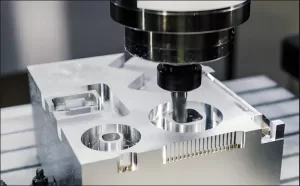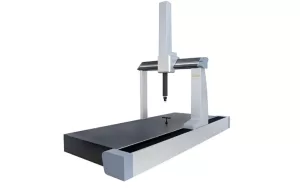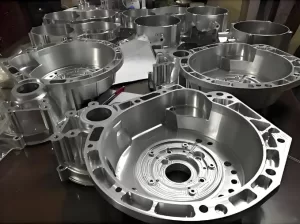February 28, 2025
Progress of precision machining technology in automobile manufacturing
As competition in the automobile market intensifies and consumer demand for safety, comfort, energy efficiency, and environmental protection rises, traditional machining methods struggle to meet the need for high-quality, diverse, and fast deliveries. The automotive industry has adopted high-precision CNC machining, intelligent flexible machining, and precision testing technologies to integrate design, process, manufacturing, and management digitally. This shift has become essential for the transformation of automotive manufacturing.
1. Application Status of Precision Machining Technology in Automotive Manufacturing
1.1 High-Precision CNC Machining
High-precision CNC machining plays a key role in manufacturing critical automotive components efficiently. CNC systems and machine tools have made it possible to process complex parts, cut difficult materials precisely, and achieve high-speed milling for special surfaces.
For example, engine components such as cylinder blocks, cylinder heads, crankshafts, and connecting rods require extremely high machining accuracy and surface quality. Five-axis CNC machining centers equipped with precision servo motors and ball screws have significantly improved machining efficiency and precision. These centers support lightweight engine designs. In transmission manufacturing, CNC hobbing, milling, and grinding, combined with online inspection, enhance gear accuracy and extend transmission life.

For car body manufacturing, gantry five-axis machining centers create large molds and welding fixtures. With CNC deep-hole drilling and special milling tools, these centers enable high-speed, high-precision cutting of complex surfaces, shortening mold manufacturing cycles.
1.2 Precision Measurement and Inspection Technology
Precision measurement is critical to ensuring automotive product quality. As vehicle structures grow more complex, the demand for advanced measurement tools increases. Three-coordinate measuring machines (CMM) are widely used in automotive manufacturing for tasks like body-in-white size measurement and engine block hole detection. Laser trackers, used for large-size workpieces, have become essential tools for precision measurement.

1.3 Intelligent Flexible Machining Systems
Traditional automotive manufacturing uses dedicated production lines, often resulting in low equipment utilization and difficulties in adapting to customized, multi-species production. Intelligent flexible machining systems combine CNC technology, industrial robots, and automated material handling. These systems enable quick production switching and consistently high-quality results, improving efficiency.
For example, body-in-white flexible welding production lines use modular fixtures that can be easily replaced for different models. Industrial robots handle key processes like welding, positioning, and handling with over 90% automation. Each process is equipped with online monitoring and compensation systems that automatically adjust equipment parameters when deviations are detected to ensure quality.
1.4 Advanced Manufacturing Technologies for New Energy Vehicles
In new energy vehicle (NEV) production, integrated die-casting and multi-material hybrid molding technologies are widely used.
One-piece die casting joins multiple parts into a single casting, reducing costs and increasing body stiffness. Tesla’s Model Y, for example, uses the world’s largest aluminum die-casting machine, producing only two oversized castings for the rear body. Multi-material hybrid forming combines high-strength steel, aluminum alloy, and carbon fiber to optimize mechanical properties, improving safety, reducing weight, and increasing range.
2. Development Trends in Precision Machining Technology
2.1 Green and Intelligent Manufacturing
The automotive industry is accelerating its shift toward green and intelligent manufacturing, driven by energy-saving, environmental protection, and sustainability goals. Innovations in cutting tool materials, optimized cutting parameters, and advanced fluid delivery methods have significantly reduced energy consumption, material waste, and emissions.
Technologies such as in-spindle cooling and dry cutting minimize the use of cutting fluids, improving workshop environments. CNC machine tools, industrial robots, and logistics systems use energy-saving measures, like frequency conversion and energy feedback, to reduce energy consumption. Additionally, technologies like heat pump air conditioning and energy-efficient systems balance heat and humidity in workshops.
2.2 New Processing Techniques
The automotive industry faces challenges with new materials such as high-tensile steel, aluminum alloys, composites, and ceramics used in key components. New breakthroughs in ultra-high-speed cutting, carbide cutting, and metal matrix composite cutting have improved machining efficiency for critical parts like turbine blades and engine pistons.

2.3 Digital Integration Technology
Digitalization and intelligence have become core competencies for leading OEMs. Digital twins are now applied across the vehicle lifecycle to simulate and analyze vehicle performance, optimize production processes, and guide predictive maintenance.
Systems like CAD/CAM and CAPP streamline the design, process, and manufacturing phases, enabling collaborative design and part processing. Automation networks equipment like CNC systems, robots, and AGVs, forming an IoT architecture that supports efficient production. The PLM platform integrates product lifecycle management and connects the entire value chain, facilitating digital transformation across the automotive industry.
3. Conclusion
As the automotive industry continues to evolve, high-precision CNC machining, intelligent flexible systems, and advanced manufacturing technologies will lead the transformation. These innovations improve production efficiency, product quality, and the ability to meet customer needs. Advancements in digitalization, green manufacturing, and new processing techniques will enable the automotive industry to excel in personalized, large-scale manufacturing and fuel the future growth of new energy vehicles.